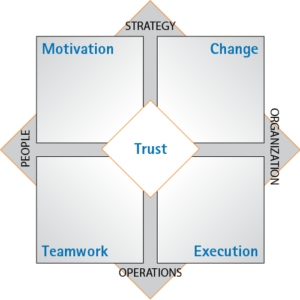The Komatsu Case
Increasing Employee EngagementIn a six month leadership development process at Komatsu using the Six Seconds’ Vital Signs framework, engagement increased by 112%. At the same time, plant performance increased by 9.4%.
Background
Komatsu is the world’s second largest manufacturer of construction equipment and mining equipment after Caterpillar. This case study focuses on a plant in Italy just after a global recession. In this recessionary climate, the management faced serious struggles, especially low employee engagement. HR Director, Francesco Blasi, explains: “We were in a period of crisis. But we still needed to be able to team up and go forward, so we recognized that this time of difficulty could also be a time of opportunity. We needed to take this opportunity to change perspectives in our company culture to develop the skills of the employees who would help the company grow after the recession. We needed to build employee engagement.”
Komatsu partnered with Six Seconds to increase the engagement of its employees. The project with Six Seconds blended the use of assessments, trainings, and project-based learning to involve manager in creating a new vision of engagement. This case study focuses on 24 second-line managers.
EQ Impacts Employee Engagement
Which Drives Plant Performance
%
Increase in Employee Engagement after Vital Signs Intervention
%
Increase in Plant Performance after Vital Signs Intervention
How can emotional intelligence help…?
Measure Employee Engagement
Statistically reliable assessments give you the data you need to understand baselines and measure progress. Learn More
Increase Employee Engagement
Employees who are more engaged go above and beyond, creating thriving workplaces and better bottom lines. Learn More
Enhance Performance
Organizations with higher engagement are more efficient, contributing to lower costs and higher profits. Learn More
“People felt good…”
“Looking at the environment in the training, people felt good – it was practical, but also warm. They then worked to re-create this experience for others in the company. This added value. And we can definitely see that for many people, the word ‘emotion’ is no longer taboo.”
-Francesco Blasi, HR Director, KOMATSU
1. Can Employee Engagement Be Measured?
In this case study, Employee Engagement was measured with TVS (Team Vital Signs), a statistically reliable research process designed to pinpoint areas assisting and interfering with growth and bottom-line success.
According to the Vital Signs Manual[3], a high performing team climate is driven by these five factors: Trust, Motivation, Change, Teamwork, and Execution.

The Five, Measurable Drivers
Trust: People have a sense of safety and assurance so they’ll take risks, share, innovate, and go beyond their own comfort zones.
Motivation: People need to feel energized and committed to doing more than the minimum requirement.
Change: Employees and the institution are adaptable and innovative.
Teamwork: People feel collaboration and communicate to take on the challenges.
Execution: Individuals are both focused and accountable.
The TVS & Measuring Overall Engagement
The TVS is a validated measure normed with hundreds of organizations and over 50,000 administrations across Asia, Europe, and the Americas, in nine languages. The tool generates normative scores for each factor on a scale from 50-150 with 100 as the mean.
An additional scale in the TVS is a measure of engagement, which represents an overall view of the participants’ commitment to the organization. The “Engagement Index” is based on ratio of the number of employees who are actively engaged (fully committed) vs neutral vs disengaged (not committed). The Engagement Index is reported on a scale from 0 to 100, with 50 as a mean score.
2. Does Emotional Intelligence Increase Employee Engagement?
The preliminary assessment revealed a significant challenge in employee engagement. Only 8.3% of the management team scored in the “Engaged” category, and the overall “Engagement Index” score was 33 (the mean score on this index is 50; the benchmark for high performance is 80).
Overall Engagement
After the Team Vital Signs intervention, the “Overall Engagement Index” score increased to 70.
- PRE-TVS Intervention, Overall Engagement
- POST-TVS Intervention, Overall Engagement
Disengagement in Employees Drops by 33%
While overall engagement increased by 112%, the percentage of disengaged employees dropped from 41.6% to 9%, representing a large-scale shift in attitude.
- PRE-TVS Intervention, Disengaged Employees
- POST-TVS Intervention, Disengaged Employees
Discussion: EQ & Organizational Engagement
The study is based on a small group of managers, but it shows that effective teamwork has a significant effect on the larger community. Targeted training to build emotional intelligence with these managers had a ‘ripple effect’ that positively impacted the engagement of the entire plant. Using an “emotionally intelligent” process for building and supporting teams seems to work.
In a time when employees are disconnected and managers struggle to build alignment, the Komatsu Case offers crucial insights. The key strategies are summarized at the end of the case. The key is recognizing that people are not solely rational – if we don’t get smart about the emotional drivers of engagement, we’ll lose.
3. Does Emotional Intelligence Impact Performance?
Komatsu found the need to redefine to the way they measured performance. They decided to revise the internal performance management system to create more participation, an EQ value they learned would increase performance. They developed a “360” feedback process to include supervisors, colleagues, and co-workers in performance appraisal.
Results
It worked; plant performance increased by 9.3% post TVS-Intervention.
- PRE-TVS Intervention Performance Score
- POST-TVS Intervention Performance Scores
Recommendations
What can managers and consultants learn from the case? Remember, the project occurred in a time of crisis. Often, that means withdrawing & protecting… but driven by the demands “to be ready for the next opportunity,” managers had an opportunity to take a risk.
As Google’s Project Aristotle so clearly demonstrated, the risk to change will only happen in a context of psychological safety. So emotionally intelligent leadership is key.
Three insights we can take to business today:
1. To create change, people need to change. Involving the managers in a new way of thinking and working provided them with insights and tools to experiment with alternatives. The playful, project-driven approach offered an invitation for managers to take the risk and try something new.
2. Provide Meaningful Data for the People-Side. Powerful, innovative teams have a mix of styles, talents, EQ skills, and capabilities. Managers who understand this data about people are equipped to be more insightful and make better decisions with and about people.
3. Create choice. In a context of major challenge & uncertainty, people feel stuck – and powerless. Yet when people self-select, they have power. They become more committed to the process, and they feel ownership of the results. This means leveraging the power of autonomy and putting solutions into your people’s hands.
What are your take aways from this case? Share in the comments below.
“The teams showed great enthusiasm and really wanted to achieve the goal. There was a strong team spirit within each group and very positive energy was created.”
This study originally published Dec 11, 2013, updated Sept 23, 2020
The Authors

Joshua Freedman
CEO, Six Seconds

Massimiliano Ghini
Board Member, Six Seconds
In Collaboration with Anna Maria Caotta
From Our Clients
“Probably the best training course I have ever attended in 25 years of business.”
“EQ is crucial for business development and yet in nearly 30 years of working in corporates, I have never had EQ explained, demonstrated and presented in this most engaging fashion. A superb facilitator who shared abundantly. This is truly the BEST program I’ve attended in 20 years.”
“Emotions are so incredibly valuable and yet discounted so much of the time. This course connects the dots to bring the value proposition of emotions to the workplace.”
Recent Articles
Emotional Intelligence at Work: In the Era of AI, What Happens to Human Skills?
Who’s winning the artificial intelligence race: machines or people? Research finds AI investment leads to disinvestment in human skills
Emotional Intelligence at Work: Exploring the Principles of Exceptional Leaders
Check out these 7 valuable leadership lessons to be the best leader you can be and bring the best out of people.
3 Winning Strategies for Successful Change Leadership: Coaching with Emotional Intelligence
Can coaching tools help you lead successful organizational change? Here’s how to build team ownership and drive better outcomes by applying emotional intelligence for a coaching mindset.
Emotional Intelligence at Work: New Research Reveals 5 Practical Tips to Make Workplace Boredom Beneficial
How to navigate boredom in a healthy and productive manner as an employee and as an entire organization. New research reveals key insights.
Emotional Intelligence at Work: Slack Study Finds Massive Benefits to Taking Breaks, but Half of Employees Don’t Take Them
Research from Slack’s Workforce Index found that making time for breaks during the workday improves employee wellbeing and productivity
Emotional Intelligence at Work: The Free, Easy Win Most Managers Are Missing
Gallup study compares the biggest gaps in employee vs. manager perceptions. What are managers’ worst blind spots? What are easy wins they could do better to improve team performance?
Let’s Work Together
- Enhance Emotional Literacy - July 13, 2023
- Plutchik’s Wheel of Emotions: Feelings Wheel - March 13, 2022
- Technology Loneliness: EQ Tips from Daniel Goleman - October 24, 2020














An amazing and wonderful experience and a sense of immersive incense in this featured program.
Even though we all believe the importance of employee engagement to company’s success, many organization facing difficulties to work with engagement program. It is so great to see the powerful evidence of how SEI and 6seconds models could really help organizations. Inspiring.
Very useful article to engage me to continue working towards my mission and feel confident about the 6seconds model and tools.
Amazing case study. By sharing this with us, it gives us the permission to go out and try to create the same – thank you Six Seconds.
Wow — powerful results! Thanks to Six Seconds for pioneering this important work!
I really appreciated the SEI assesment and the teamwork gave me an improved corporate awarness
I was the leader of the Team 3: Performance Assessment. Great experience!